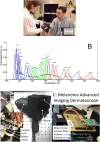Hyperspectral imaging in automated digital dermoscopy screening for melanoma
- PMID: 30653684
- PMCID: PMC6519386
- DOI: 10.1002/lsm.23055
Hyperspectral imaging in automated digital dermoscopy screening for melanoma
Abstract
Objectives: Early melanoma detection decreases morbidity and mortality. Early detection classically involves dermoscopy to identify suspicious lesions for which biopsy is indicated. Biopsy and histological examination then diagnose benign nevi, atypical nevi, or cancerous growths. With current methods, a considerable number of unnecessary biopsies are performed as only 11% of all biopsied, suspicious lesions are actually melanomas. Thus, there is a need for more advanced noninvasive diagnostics to guide the decision of whether or not to biopsy. Artificial intelligence can generate screening algorithms that transform a set of imaging biomarkers into a risk score that can be used to classify a lesion as a melanoma or a nevus by comparing the score to a classification threshold. Melanoma imaging biomarkers have been shown to be spectrally dependent in Red, Green, Blue (RGB) color channels, and hyperspectral imaging may further enhance diagnostic power. The purpose of this study was to use the same melanoma imaging biomarkers previously described, but over a wider range of wavelengths to determine if, in combination with machine learning algorithms, this could result in enhanced melanoma detection.
Methods: We used the melanoma advanced imaging dermatoscope (mAID) to image pigmented lesions assessed by dermatologists as requiring a biopsy. The mAID is a 21-wavelength imaging device in the 350-950 nm range. We then generated imaging biomarkers from these hyperspectral dermoscopy images, and, with the help of artificial intelligence algorithms, generated a melanoma Q-score for each lesion (0 = nevus, 1 = melanoma). The Q-score was then compared to the histopathologic diagnosis.
Results: The overall sensitivity and specificity of hyperspectral dermoscopy in detecting melanoma when evaluated in a set of lesions selected by dermatologists as requiring biopsy was 100% and 36%, respectively.
Conclusion: With widespread application, and if validated in larger clinical trials, this non-invasive methodology could decrease unnecessary biopsies and potentially increase life-saving early detection events. Lasers Surg. Med. 51:214-222, 2019. © 2019 The Authors. Lasers in Surgery and Medicine Published by Wiley Periodicals, Inc.
Keywords: artificial intelligence; dermoscopy; hyperspectral imaging; machine learning; melanoma.
© 2019 The Authors. Lasers in Surgery and Medicine Published by Wiley Periodicals, Inc.
Figures




Similar articles
-
Computer-assisted diagnosis techniques (dermoscopy and spectroscopy-based) for diagnosing skin cancer in adults.Cochrane Database Syst Rev. 2018 Dec 4;12(12):CD013186. doi: 10.1002/14651858.CD013186. Cochrane Database Syst Rev. 2018. PMID: 30521691 Free PMC article.
-
Digital imaging biomarkers feed machine learning for melanoma screening.Exp Dermatol. 2017 Jul;26(7):615-618. doi: 10.1111/exd.13250. Epub 2016 Dec 19. Exp Dermatol. 2017. PMID: 27783441 Free PMC article.
-
[The Rise of Artificial Intelligence - High Prediction Accuracy in Early Detection of Pigmented Melanoma].Laryngorhinootologie. 2023 Jul;102(7):496-503. doi: 10.1055/a-1949-3639. Epub 2022 Dec 29. Laryngorhinootologie. 2023. PMID: 36580975 German.
-
Results of the 2016 International Skin Imaging Collaboration International Symposium on Biomedical Imaging challenge: Comparison of the accuracy of computer algorithms to dermatologists for the diagnosis of melanoma from dermoscopic images.J Am Acad Dermatol. 2018 Feb;78(2):270-277.e1. doi: 10.1016/j.jaad.2017.08.016. Epub 2017 Sep 29. J Am Acad Dermatol. 2018. PMID: 28969863 Free PMC article.
-
Role of In Vivo Reflectance Confocal Microscopy in the Analysis of Melanocytic Lesions.Acta Dermatovenerol Croat. 2018 Apr;26(1):64-67. Acta Dermatovenerol Croat. 2018. PMID: 29782304 Review.
Cited by
-
Deep learning diagnostics for bladder tumor identification and grade prediction using RGB method.Sci Rep. 2022 Oct 21;12(1):17699. doi: 10.1038/s41598-022-22797-7. Sci Rep. 2022. PMID: 36271252 Free PMC article.
-
Zebrafish in dermatology: a comprehensive review of their role in investigating abnormal skin pigmentation mechanisms.Front Physiol. 2023 Nov 23;14:1296046. doi: 10.3389/fphys.2023.1296046. eCollection 2023. Front Physiol. 2023. PMID: 38074315 Free PMC article. Review.
-
Synchronous and metachronous melanomas diagnosed at early stages in a patient with dysplastic nevus syndrome.An Bras Dermatol. 2023 Jul-Aug;98(4):556-558. doi: 10.1016/j.abd.2021.12.011. Epub 2023 Mar 13. An Bras Dermatol. 2023. PMID: 36922333 Free PMC article. No abstract available.
-
Tissue classification of oncologic esophageal resectates based on hyperspectral data.Int J Comput Assist Radiol Surg. 2019 Oct;14(10):1651-1661. doi: 10.1007/s11548-019-02016-x. Epub 2019 Jun 20. Int J Comput Assist Radiol Surg. 2019. PMID: 31222672
-
Acne Detection Based on Reconstructed Hyperspectral Images.J Imaging. 2024 Jul 23;10(8):174. doi: 10.3390/jimaging10080174. J Imaging. 2024. PMID: 39194963 Free PMC article.
References
-
- Salerni G, Terán T, Puig S, et al. Meta‐analysis of digital dermoscopy follow‐up of melanocytic skin lesions: A study on behalf of the International Dermoscopy Society. J Eur Acad Dermatol Venereol 2013;27:805–814. - PubMed
-
- Friedman RJ, Gutkowicz‐Krusin D, Farber MJ, et al. The diagnostic performance of expert dermoscopists vs a computer‐vision system on small‐diameter melanomas. Arch Dermatol 2008;144:476–482. - PubMed
-
- Haenssle HA, Fink C, Schneiderbauer R, et al. Man against machine: Diagnostic performance of a deep learning convolutional neural network for dermoscopic melanoma recognition in comparison to 58 dermatologists. Ann Oncol 2018;29:1836–1842. - PubMed
Publication types
MeSH terms
Substances
Grants and funding
LinkOut - more resources
Full Text Sources
Other Literature Sources
Medical
Molecular Biology Databases

